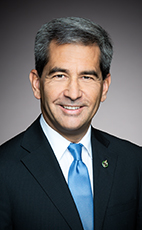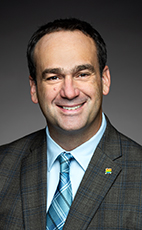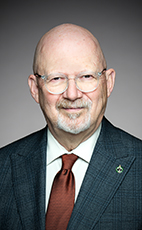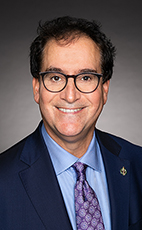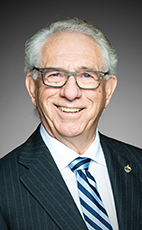44th Parl. 1st Sess.
April 5, 2022 10:00AM
- Apr/5/22 10:34:31 a.m.
- Watch
Mr. Speaker, I have been looking forward to joining the debate on this motion. As a former member of the military, I understand the importance of adequate funding for national defence and the importance of Canada's role on the international stage.
The purpose of the debate is to bring all parliamentarians to a clear consensus on our defence posture. The motion specifically calls for an increase in the defence budget to reach the NATO target. However, we also need to find another time to discuss the state of the troops and lack of members. There is a reason for all that, but we will come back to it another day.
From the outset, I must say that the Liberals' rhetoric about military spending has never translated into concrete action, and that is very disappointing. Most frightening is this recent partnership between the Liberal Party and the NDP socialists. It is no secret that the NDP has never been in favour of a healthy and well-funded Canadian military. Under a NDP government, the Canadian Armed Forces' budget would basically be eviscerated. As a result of this romance between the Liberals and the NDP, there is uncertainty among our troops across the country and abroad.
When Russia invaded Ukraine, all NATO partners were again challenged to meet or maintain the defence spending requirement of 2% of GDP, 20% of which must be allocated to military equipment. This renewed commitment had actually been discussed at the 2014 NATO summit in Wales, in response to Russia's illegal annexation of Crimea and the unrest in the Middle East at that time. NATO leaders agreed to reverse the downward trend in defence spending and decided that the allies already meeting the 2% guideline on defence spending would strive to continue doing so and that the allies spending less than 2% of their GDP on defence would strive to increase that spending in real terms within 10 years.
That commitment was made in 2014, and now, eight years later, Canada ranks 25th out of the 30 NATO countries in terms of military spending. NATO's latest annual report shows that Canada spent just 1.36% of its GDP on the army and new defence equipment in 2021.
In contrast, the Conservative Party of Canada declared in its policy statement that a Conservative government will work towards spending at least the NATO recommended 2% of our GDP on national defence. Furthermore, in our latest platform, in 2021, we said, “Canada’s Conservatives will renew Canada’s commitment to NATO by increasing spending on national defence to move closer to our 2% aspirations”.
The large-scale invasion of Ukraine by Russia, accompanied by mounting evidence of war crimes in full view of anyone on social media, clearly gives Canada good reason to considerably increase its defence spending.
There is no doubt that Canada's biggest challenge has always been its procurement system, which involves too many departments and not enough political responsibility. This system essentially created a bottleneck that prevents even the current budget increase from being spent effectively. The lack of political leadership keeps projects from moving quickly. Every independent procurement expert who testified before our committees has said as much.
According to the most recent public accounts, $1.2 billion of 2021 defence spending was not invested, despite the fact that the Liberal's 2015 election platform explicitly states, “We will not let Canada’s Armed Forces be shortchanged, and we will not lapse military spending from year to year.” However, last month the Parliamentary Budget Officer released a report detailing how the Liberals are constantly pushing spending to coming years. In other words, the Liberals have consistently broken their promise to invest in new equipment.
To be honest, when the “Strong, Secure, Engaged” defence policy was published in 2017, I was impressed. During a meeting of the Standing Committee on National Defence, at the time, I remember saying to the chief of the defence staff and the Minister of Defence that 80% of what was in the white paper advocated a Conservative approach. I asked how they were going to fund it. The told me that the decision was not theirs to make. We saw what happened next.
At the same time, Canada's defence policy entitled “Strong, Secure, Engaged” demonstrates how the Liberals calculate defence investments so as to meet NATO criteria. It is as though they are comparing this year's 1.34% with the Conservatives' percentage, which the Liberals estimate at just under 1%. We need to compare apples to apples and oranges to oranges.
The Liberals added elements to the NATO calculations. There are ongoing discussions about applying the same yardstick. Certain elements have been included, such as payments made to veterans. They were not part of the NATO calculations, nor were peacekeeping and humanitarian operations, defence-related IT support, centrally funded defence personnel expenditures, or support for defence programs.
The Liberals took a look and, anywhere they saw the word “defence” or “veteran”, they decided they would take that and put it all together to inflate the percentage so they could say that they are doing more. That is the big difference between what was done by the Conservatives at the time, in other words, real and actual defence work, and the other things that the Liberals picked at here and there.
We know that the Liberals are sneakily trying to cover up their failure. However, Canadians are not fools. They see what the Liberals are doing. The only major project that the Liberals have completed in nearly seven years is buying a bunch of rusted-out CF-18s from Australia for $360 million. We congratulate them on that.
With regard to Ukraine, Canada can and must do more. We have a lot of surplus military vehicles that could be dispatched around the clock with our C-17s. However, the government has not indicated whether it has even considered such action. We could also call upon third parties to buy air defence equipment, such as Stinger missiles or drones and send them to Ukraine. Once again, the senior officials who appeared before the Standing Committee on Government Operations and Estimates repeatedly suggested that these ideas are not even being considered right now.
Furthermore, all military purchases under this Liberal government are or have been delayed. For example, when will Canada sign the notorious F-35 contract? We have been in the consortium for decades. Why do we have to wait seven months to enter into dialogue with Lockheed Martin? We have already been talking to them for quite a while now. In addition, when will construction on the polar icebreakers begin? Why is the Davie shipyard still not officially part of the national shipbuilding strategy? What is this government waiting for? How are we going to protect Canadian sovereignty in the Arctic? The NORAD alert system is totally obsolete. Has the government considered purchasing airborne warning and control system aircraft? What are we doing to speed up the procurement process? What is the status of the submarine replacement program?
In addition, this partnership between the Liberals and the NDP is a pretty good indication that this government is unlikely to increase investments in the Canadian Armed Forces in the short term. Indeed, how many times have we heard NDP statements or resolutions calling for Canada to withdraw completely from NATO?
When we, the Conservatives, were in power, we finalized the purchase of five C-17 Globemaster transport aircraft, 17 CC-130J Hercules transport aircraft, 15 Chinook helicopters and some Leopard 2 tanks. We modernized the CP-140 Aurora surveillance aircraft and the Halifax class frigates. We approved the construction of the Asterix auxiliary supply ship, which the Liberals tried to cancel at their first cabinet meeting in 2015, despite Admiral Norman's objections. We established the national shipbuilding strategy, which, despite all its problems, is finally starting to produce some ships, such as the Coast Guard's science vessels and the Arctic offshore patrol ships.
The Conservative government has always taken the need to provide adequate funding to our Canadian Armed Forces seriously, whereas the Liberals are known for spewing empty rhetoric. I will close by saying this. Let us do better in military procurement, let us be efficient and let us ensure we have the means to do so.
1410 words
All Topics
- Hear!
- Rabble!
- add
- star_border
- share
- Apr/5/22 10:44:06 a.m.
- Watch
Mr. Speaker, I thank the member for his intervention today. I know that when he and I were on the defence committee together a number of years ago, I believe it was in 2016 or 2017, the defence committee had brought forward a report that had a recommendation in it. It was the opinion of the committee at the time to increase defence spending to 2% of GDP, notwithstanding the fact that there can be a lot of complications with respect to that 2%, because not every country calculates it the same way.
Can the member comment on what, if any, work the committee has done since my time with him on that committee in terms of making any further recommendations around this issue?
124 words
- Hear!
- Rabble!
- add
- star_border
- share
- Apr/5/22 10:44:57 a.m.
- Watch
Mr. Speaker, I thank my colleague for the question.
I am no longer a member of the Standing Committee on National Defence, so I am not completely up to date on all the reports that have been produced over the past five years, but the fact remains that the 2% issue keeps coming up. Something tangible needs to be done. The budgets have been lacking the past few years. For example, there is the “Strong, Secure, Engaged” policy. The committee can say what it wants, and it makes recommendations in its reports that are often quite good, but the government never follows through.
105 words
- Hear!
- Rabble!
- add
- star_border
- share
- Apr/5/22 10:45:39 a.m.
- Watch
Mr. Speaker, there is some catching up to do when it comes to equipment. My colleague talked about that. The national shipbuilding strategy is very costly and is experiencing near‑record delays.
Would immediately fast-tracking the inclusion of a third shipyard be a solution not only to improve this 2%, but also to increase youth engagement in our naval force and in shipbuilding?
65 words
- Hear!
- Rabble!
- add
- star_border
- share
- Apr/5/22 10:46:13 a.m.
- Watch
Mr. Speaker, I thank my colleague for the question. Everything having to do with defence forms a big circle. Having operational resources and good, modern equipment encourages young people to enrol in the Canadian Forces and serve their country.
I doubt that 17- or 18-year-olds are reassured by what is happening with the jets and the ships. They are not sure what is going to happen. Eventually, they will decide to do something else with their life.
An acquaintance of mine, who had dual French and Canadian citizenship and wanted to be a pilot, decided to return to France after seeing the state of the F‑18s compared to France's aircraft. Now he is piloting French jets. That just proves that we really do not have anything to offer that would appeal to young Canadians, unfortunately.
140 words
- Hear!
- Rabble!
- add
- star_border
- share
- Apr/5/22 10:47:07 a.m.
- Watch
Mr. Speaker, I think the hon. member for Charlesbourg—Haute-Saint-Charles has missed a couple of things. I know he was only elected in 2015, so he missed the fact that the Conservatives let defence spending drop to its lowest level since the 1930s while they were in government. He seems to have missed that the NDP has voted for every increase in military spending since 2016. He also seems to have missed that the NDP changed its policy on NATO nearly 30 years ago.
I wonder if the hon. member would like to explain how the Conservatives have gone from taking defence spending to its lowest level ever to now endorsing an arbitrary doubling of defence spending.
120 words
- Hear!
- Rabble!
- add
- star_border
- share
- Apr/5/22 10:47:44 a.m.
- Watch
Mr. Speaker, I thank the member for his question. Those were different times. Let us not forget Afghanistan and spending on the operation in Afghanistan. The equipment I mentioned in my speech was purchased by the Conservatives to quickly meet an urgent need to support the troops.
Ask anyone who was in the Canadian Armed Forces when the Conservative government was in power if they were ashamed to serve their company, and no one would say they were. The military knew very well that the Conservative government was there to support them to the fullest extent, and that it could react quickly and send in the operational equipment that was needed on the ground. That is more important than any speech.
121 words
- Hear!
- Rabble!
- add
- star_border
- share
- Apr/5/22 10:48:27 a.m.
- Watch
Mr. Speaker, I want to thank and congratulate my colleague for the good work that he does at the Standing Committee on Government Operations and Estimates and on this type of national security file.
I filled in for my colleague once at a committee. At that meeting, we learned that contracts to upgrade radar systems in the Canadian Arctic had not been awarded.
Are there concerns about the government's refusal to upgrade radar systems in the Canadian Arctic?
79 words
- Hear!
- Rabble!
- add
- star_border
- share
- Apr/5/22 10:48:57 a.m.
- Watch
Mr. Speaker, I thank my colleague from Lévis—Lotbinière. The Arctic is an immense and complex area that requires surveillance. Essentially, that requires an effective radar system. At present, the radar system in place is outdated. The government has stated that it has invested more than $600 million, but that is for standard maintenance. It is not deploying any new equipment. The U.S. is worried and is asking us to do our fair share and invest in equipment in order to provide air and maritime surveillance as quickly as possible.
97 words
- Hear!
- Rabble!
- add
- star_border
- share
- Apr/5/22 10:49:37 a.m.
- Watch
Mr. Speaker, I will be splitting my time with the member for Don Valley West this morning.
I rise in the House to talk about the progress we have made in implementing Canada's defence policy of Strong, Secure, Engaged. When we first released SSE back in 2017, we provided a comprehensive list of capital projects, policies and procedures to ensure that our military could meet our biggest defence and security threats now and into the future. To help fund these items, SSE also forecasted a steady increase in defence spending from $18.9 billion in 2017-18 to $32.7 billion in 2026-27. That is an increase of 70% to our defence spending. Even prior to the COVID-19 pandemic, Russia's unprovoked war in Ukraine and the myriad of other defence and security challenges we have faced over the past five years, we were already on track to increase defence spending by more than 70%.
While SSE remains our main guide for making sure CAF members are well supported and well equipped, the evolving global security environment has underscored just how important and urgent our investments in defence are. That is why, as both the Prime Minister and the Minister of National Defence have indicated, we will be further increasing our investments in defence, including a comprehensive spending package going toward continental defence.
With that in mind, I want to give the House an update on the progress that DND has made in implementing this policy so far, and on the work that we are doing to safeguard our country and continent and support our allies and partners in good times and in bad. Key to these efforts is having a well-supported, resilient workforce that feels safer coming to work every day. When DND launched SSE in 2017, it included several critical initiatives aimed at supporting CAF members and their families throughout their entire careers. This included developing a total health and wellness strategy with the goal of supporting defence team members' mental and physical well-being at all times.
I am pleased to note that National Defence launched this strategy earlier last month. Over the next several years, it will invest more than $950 million to enhance health and wellness programs and services for defence team members, including expanding the Office of Disability Management by adding more regional offices across the country, providing personalized support services to injured, ill and impaired public service employees, and improving care for Canadian Armed Forces members who are recovering from an illness or injury. Through SSE, National Defence has also done important work expanding the services offered to military families through military family resource centres, and has helped address the challenges that come with a life in uniform through the seamless Canada initiative, which helps to address gaps in service when military families are posted across the country and must navigate new school systems, careers and health care settings.
These are just a couple of the initiatives in SSE aimed at supporting defence team members and their families. We know that Canada's position in the world and our safety and security here at home come down to the well-being of those who serve in it. All that we do, from procurement to health care to cultural change, must be focused on the people who put service before self, the members of our Canadian Armed Forces.
At the same time, we know that our people in uniform need the right equipment to do the difficult jobs that we ask of them. They need state-of-the-art fit-for-purpose tools that can meet the challenges of modern warfare across all domains. In SSE, National Defence outlined over 300 capital projects critical to our military success and our continued interoperability with allies and partners for decades to come. While the COVID-19 pandemic has certainly contributed to project delays and supply chain disruptions, we remain committed to delivering on these projects, providing the very best equipment for our people in uniform while ensuring Canada's economy benefits from our defence investments.
Despite the challenges of the past few years, we are making progress. In fact, since 2017, 75% of the policy's capital projects, which is 258 projects, are in the implementation phase, near completion or completed. Several high-profile projects kept moving forward even as much of the world shut down.
Just last week, the Minister of Public Service and Procurement and the Minister of National Defence announced that Canada was moving into the finalization phase of the future fighter competition with Lockheed Martin and the U.S. government. If an agreement is successfully reached, Canada could see initial aircraft deliveries as early as 2025. This is the most significant investment in the Royal Canadian Air Force in over 30 years, so we have been taking the time. We need to get this right and ensure that we are purchasing the right jet with the right value for CAF and Canadians.
We have taken the same careful, considered approach to building our fleet of Arctic and offshore patrol ships for the Royal Canadian Navy. The first of these ships, HMCS Harry DeWolf, has already participated in missions like Operation Nanook and Operation Caribbe, and has transited through the Panama Canal. It also recently completed a circumnavigation of North America, the first Royal Canadian naval ship to do so since 1954. The second ship, HMCS Margaret Brooke, has completed the ship's icebreaking and Arctic environmental trials and will return to Arctic waters to participate in the maritime portion of Operation Nanook this summer. The third, fourth and fifth AOPS are in various stages of construction, with the construction of the sixth AOPS expected to begin later this year.
As we deliver on these critical projects for our navy and air force, we are also delivering on our promise to provide the Canadian army with a fleet of 360 armoured combat support vehicles. These vehicles have been designed to replace our current fleet of LAV II Bison and M113 tracked LAV fleet. They are more mobile with longer operational range, better equipped to conduct operations at night and in bad weather and safer for our people in uniform, offering improved protection against weapons and explosives. The first of these vehicles are expected to be delivered to the Canadian army later this year.
The investments under Canada's defence policy ensure that we deliver the equipment, infrastructure and innovation to help our military advance our national security objectives and interests. However, they are also critical to our national prosperity, resilience and economic well-being. As the largest federal employer, National Defence and the Canadian Armed Forces have a significant presence in every province and territory, so investing in defence also means creating more jobs and generating economic benefit for communities from coast to coast to coast. These investments also mean that we are better positioned to support our allies and partners across the globe, including those under threat from Russian aggression.
Through SSE, we are committed to remaining engaged in the world now and into the future. We are supporting Ukraine in its fight for freedom and self-governance, standing shoulder to shoulder with our NATO allies on Operation Reassurance and Operation Impact, both of which we recently extended, and deploying wherever and whenever CAF support can make a difference. In times of global uncertainty, we know that our mutual relationships are even more important, and our SSE investments will help us remain effective and a reliable, stable partner within NORAD and NATO for decades to come.
When we launched Strong, Secure, Engaged back in 2017, we made sure that it was flexible enough to deal with a rapidly evolving defence and security environment. This means that while there are certain challenges that DND and CAF could not have anticipated, chiefly the global pandemic, they have remained ready to respond and had the flexibility to adjust timelines accordingly. As we continue discussing ways to increase defence spending, this policy will remain our government's road map, enabling us to strengthen our defences here at home and help uphold peace and security across the globe.
1365 words
All Topics
- Hear!
- Rabble!
- add
- star_border
- share
- Apr/5/22 10:59:20 a.m.
- Watch
Mr. Speaker, I want to ask again about the Cormorant helicopter fleet. My understanding is that these helicopters are reaching their end of life. We are having to cannibalize parts from other helicopters to keep them in the air. They were essential in the search and rescue operations during the floods in British Columbia last summer, and they are a key factor in our air and sea search and rescue operations. Some 360 jobs would come from the upgrading and refurbishment of these helicopters, yet they were budgeted for in 2017 and nothing has happened. Fixing these helicopters would cost about $1.4 billion and would go a long way in helping us meet our NATO target of 2%.
Could the member comment on that specific project?
127 words
- Hear!
- Rabble!
- add
- star_border
- share
- Apr/5/22 11:00:14 a.m.
- Watch
Mr. Speaker, the safety of our personnel is always top of mind and the RCAF has a robust flight safety program. We know that we need to move forward in looking at a procurement project for these. As the member spoke about, cracks were discovered on the tail of the Cyclone helicopter undergoing a recent maintenance inspection. We know that we need to maintain safe equipment for all members of CAF, and we will make sure that all equipment is capable before it is used.
85 words
- Hear!
- Rabble!
- add
- star_border
- share
- Apr/5/22 11:01:01 a.m.
- Watch
Mr. Speaker, my colleague spoke about the importance of securing the supply chain, which has been weakened during the pandemic.
I would like to talk about something that is very important for Quebec. The government is set to spend a huge amount of money on F-35s, but there is no guarantee of any industrial or technological benefits. Quebec accounts for more than 50% of Canada's aerospace industry.
When will the member's government adopt a real aerospace policy that recognizes the importance of this sector, in particular in Quebec? This could help secure our supply chain.
98 words
- Hear!
- Rabble!
- add
- star_border
- share
- Apr/5/22 11:01:43 a.m.
- Watch
Mr. Speaker, I too share this interest. Being the member of Parliament for Cambridge, we have a number of companies in my riding in the aerospace industry, such as Honeywell, formerly COM DEV, among others. This is something that is critically important to our moving forward to ensure that any procurements, whether it be the fighter jets or others, benefit us not just by having the right equipment for members of CAF but also, wherever possible, by helping our local economies here in Canada.
84 words
- Hear!
- Rabble!
- add
- star_border
- share
- Apr/5/22 11:02:26 a.m.
- Watch
Mr. Speaker, I thank my hon. colleague for his work on the Standing Committee on National Defence. It has been quite an honour. In terms of the procurement of the new fighter jets, of course, there must be fiscal impact assessments. However, I want to ask and ensure that the government will be performing an environmental impact assessment on this procurement process and also, under our obligations regarding the United Nations Declaration on the Rights of Indigenous Peoples, be doing an indigenous impact assessment as well.
86 words
- Hear!
- Rabble!
- add
- star_border
- share
- Apr/5/22 11:03:01 a.m.
- Watch
Mr. Speaker, I thank my colleague for the work that she does on the committee. I want to assure all in the House that everything this government does has both an environmental lens attached to it and a first nations lens attached to it. We have ensured and will continue to ensure that we are taking the steps needed to select the right fighter jet at the right price with the right benefits to the Canadian Armed Forces and our economy.
81 words
- Hear!
- Rabble!
- add
- star_border
- share
- Apr/5/22 11:03:39 a.m.
- Watch
Mr. Speaker, I am very appreciative to the parliamentary secretary for his excellent work representing the women and men of the Canadian Armed Forces. We often can forget that families serve with members, and it is very important that the forces support those family members as well. I am proud to represent Halifax, the home of Canada's east coast navy, and recently home to HMCS Halifax, which has embarked on Operation Reassurance to support our work with NATO with regard to Ukraine, but it leaves the families at home. I wonder if the parliamentary secretary could instruct us on how CAF supports families with the funding we are talking about.
111 words
- Hear!
- Rabble!
- add
- star_border
- share
- Apr/5/22 11:04:25 a.m.
- Watch
Mr. Speaker, I will keep my comments brief. I want to thank the member for the question and the work that he does to support the members of the Canadian Armed Forces in his riding. I am very proud of our record on the shift that we have seen over the last number of years, since “Strong, Secure, Engaged”, in supporting families and connecting with them on the issues that make life within the military that much more challenging. The nearly billion dollars that we are spending just on health and wellness alone is a clear sign of our commitment on that front.
105 words
- Hear!
- Rabble!
- add
- star_border
- share
- Apr/5/22 11:05:16 a.m.
- Watch
Mr. Speaker, I want to begin by just giving the context in which this debate is happening. It has been more than a month since President Putin chose to unleash war on Ukraine. With every day that passes, the number of civilians, including children, killed and wounded continues to climb.
We have witnessed Russian attacks on apartment buildings, public squares, theatres and maternity hospitals. In addition, recent reports and images of what Russian forces carried out in Bucha are horrifying and they are deeply shameful. Let me be clear: We believe that this amounts to war crimes and crimes against humanity, and we are committed to holding President Putin and those supporting him accountable for their actions.
It is in this context that today's debate gives me the opportunity to strongly assert Canada's long-standing commitment to NATO, an organization whose importance has only become greater since Russia's illegal and unjustifiable invasion of Ukraine. Canada and our NATO allies are responding to Putin's aggression with unprecedented coordination as we continue to support the men and women of Ukraine as they defend themselves and fight for their country, their communities, their families and for their very lives.
It goes without saying that Canada's ties with the Ukrainian people have historical roots that run deep. This is why we were the first western country to recognize Ukraine's independence just over 30 years ago. Since then, we have developed a strong, diplomatic relationship fuelled by a passionate, engaged, intelligent and committed Ukrainian diaspora of over 1.4 million people in Canada.
In 2014, thousands of Ukrainians stood up for a democratic future. During the Revolution of Dignity, Canada supported activists, human rights defenders and civil society organizations that fought intensely and tirelessly for a free and democratic future. Today, we continue, in response to President Putin's brutality, to defend, to help, to support and to coordinate.
Canada rejects President Putin's attempts to rob Ukraine of its history, identity, democracy and independence. Putin's war is a blatant violation of international law, including the UN Charter, and threatens our shared security. Ukraine is a proud, sovereign country. Its territorial integrity must be respected. Putin has demonstrated little or no interest in resolving this crisis peacefully. Instead, he is putting millions of innocent lives at risk and causing the worst humanitarian crisis in Europe since the Second World War. In response, Canada and the international community have reacted. We are ensuring that President Putin and his neighbours will answer for their horrific and deeply shameful actions.
That is why we referred this issue very early on to the International Criminal Court. That is why we are standing with Ukraine at the International Court of Justice. That is why, with 44 other participating states, we invoked the OSCE Moscow mechanism to establish a fact-finding mission to Ukraine to report on the human rights and humanitarian impacts of Russia's illegal invasion. Importantly, Canada also cosponsored and strongly advocated for the UN General Assembly resolution on Russian aggression against Ukraine.
We are watching, but we are also acting. We are not waiting. We have been approaching our NATO allies, our OSCE allies and those around the world to ensure a coordinated response to this unprecedented aggression. That is why we will not wait until atrocities have been committed. We have been helping Ukraine defend itself. We have been doing that in a variety of ways.
Since February, in close coordination with our allies, Canada has sanctioned over 700 individuals and entities in Russia, Belarus and Ukraine. These are senior members of the Russian government, military and business people: oligarchs, including President Putin and his inner circle. We are suffocating the Putin regime to disable its military network to help end this aggression.
At the same time, we are helping Ukraine and Ukrainians defend themselves by supplying military support, lethal and non-lethal weapons. We are doing that with our NATO allies. This is the natural extension of Operation Unifier, which has been one of our proudest moments as Canadians and as the Canadian Armed Forces, ensuring that Ukraine's military has not only the tools but also the techniques and ability to defend itself. The secretary general of NATO has commended Canada repeatedly for being a leader in our engagement with Ukraine and ensuring that it has the capacity to defend itself.
In addition to Operation Unifier, we have authorized $160 million in military aid to support the Ukrainian armed forces. More than $110 million has already been provided. Since 2015, we have operated in Operation Unifier, training over 35,000 Ukrainian military and security personnel in tactical and advanced military skills through this mission, and we are pleased to announce that will be extended and will continue to March 2025.
NATO continues to be an important structure, alliance and engagement for the Canadian military to operate at its best. Canada is unequivocally and totally supportive of NATO, and our commitment to the alliance will continue under article 5 of the Washington Treaty. In the face of evolving threats, we understand the need to invest. We need to continue investing in our military. We continue under our defence policy of Strong, Secure, Engaged to reverse the Conservative spending cuts that happened during their decade in power and bring it back up to a level where Canadians can be proud. That is why we have announced an over 70% increase and are ensuring that the Canadian Armed Forces are prepared for a rapidly changing security environment.
Our allies are also increasing their defence spending and Canada must be ready to meet all the threats we are perceiving at the same time as our NATO allies will be engaged. Our government's policy and budgets generally align with the commitments laid out by the Wales Summit Declaration.
Let us be clear. Conservatives, who for a decade had big rhetoric about defence spending, had the chance to step up, had the chance to invest in NATO, had the chance to invest in our armed forces and instead decided to step back. They decided to cut our contributions and to cut our spending. We will take no lessons from the Conservatives, who allowed military spending to drop below 1% of GDP in 2013. They talk big, but when they had the opportunity to make a difference, to increase capacity, to increase engagement, they backed away. They stepped down.
After that decade, we are rebuilding the Canadian Armed Forces through a procurement strategy that is robust, intelligent and thoughtful, but we will also be engaging in the world diplomatically and through development and humanitarian assistance. Just in Ukraine, for instance, we have already provided $145 million in humanitarian assistance, which has now been fully allocated to experienced agencies like the Red Cross, the UN and other NGO partners. We are addressing gaps in the relief pipeline by delivering over 375,000 items from our stockpile. Humanitarian assistance and development is one of the building blocks for security. We will not abandon humanitarian assistance and development aid, while at the same time increasing military spending. They do necessarily go hand in hand to build a secure world.
We are also in the 21st century and this is a 21st-century war that requires 21st-century responses. That is why we are attempting to deal with the disinformation, propaganda and lies from Russia in the face of this aggression. That is why we have announced $13.4 million to the G7 rapid response mechanism to counter Putin's disinformation. We will continue to provide money, over $10 million per year, for a peace and security program that supports fragile democracies, ensuring that we do this together.
In closing, we want to build our military capacity. We want to be a continued best spender. We are already sixth in our NATO alliance with respect to spending, but we will also continue to provide the necessary humanitarian and development assistance, as well as necessary supports for fragile democracies and necessary supports to counter disinformation campaigns.
We will continue to work. We are proud of our Canadian Armed Forces. We are proud of our NATO alliance.
1368 words
All Topics
- Hear!
- Rabble!
- add
- star_border
- share
- Apr/5/22 11:14:55 a.m.
- Watch
Mr. Speaker, I heard my colleague across the way say, with respect to the Strong, Secure, Engaged defence plan, that the government is continuing to spend. I know we are in a position right now where the rest of the world is trying to impress upon Canada the need to get to 2% spending. The current government promised it would not lapse spending, but in the three years leading up to the end of the fiscal year of 2021, we have seen a $10-billion lapse in that spending.
Can he account for that, given that when COVID started we were printing new money at $5 billion a week? Can he put this into perspective as to where we are today?
121 words
- Hear!
- Rabble!
- add
- star_border
- share
- menumenu
- notificationsnotifications
- home
- mailmail
- searchsearch



